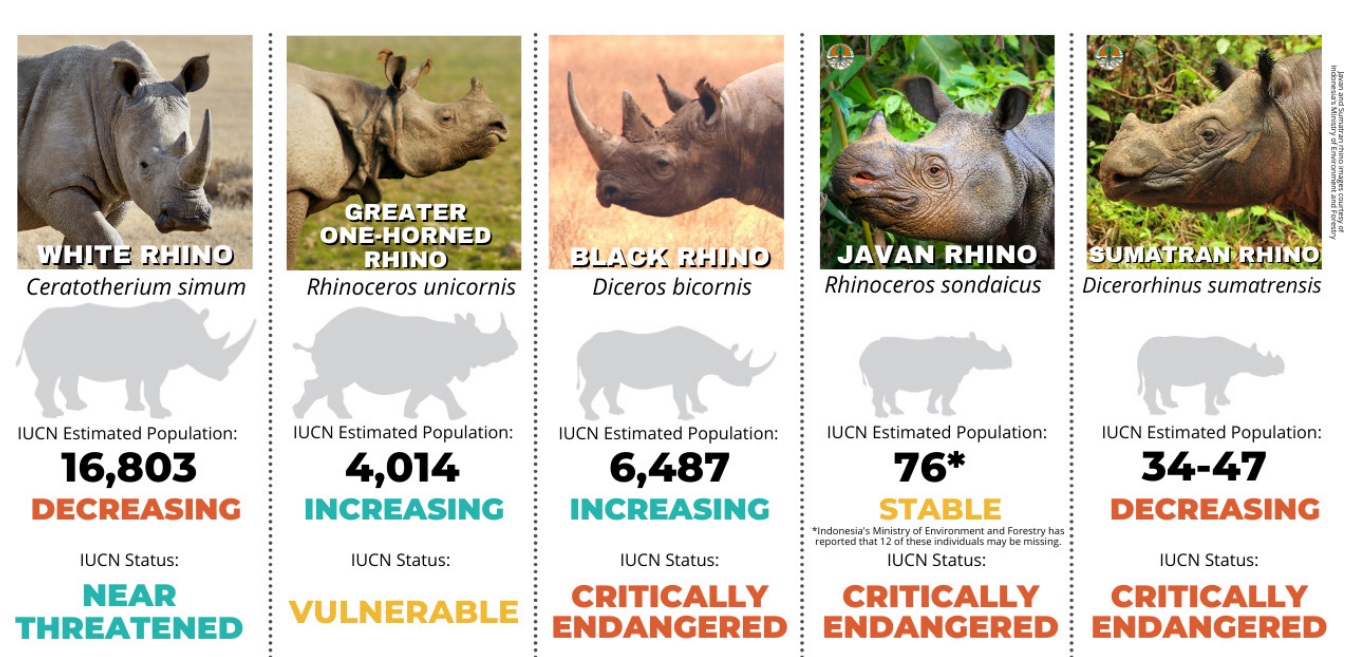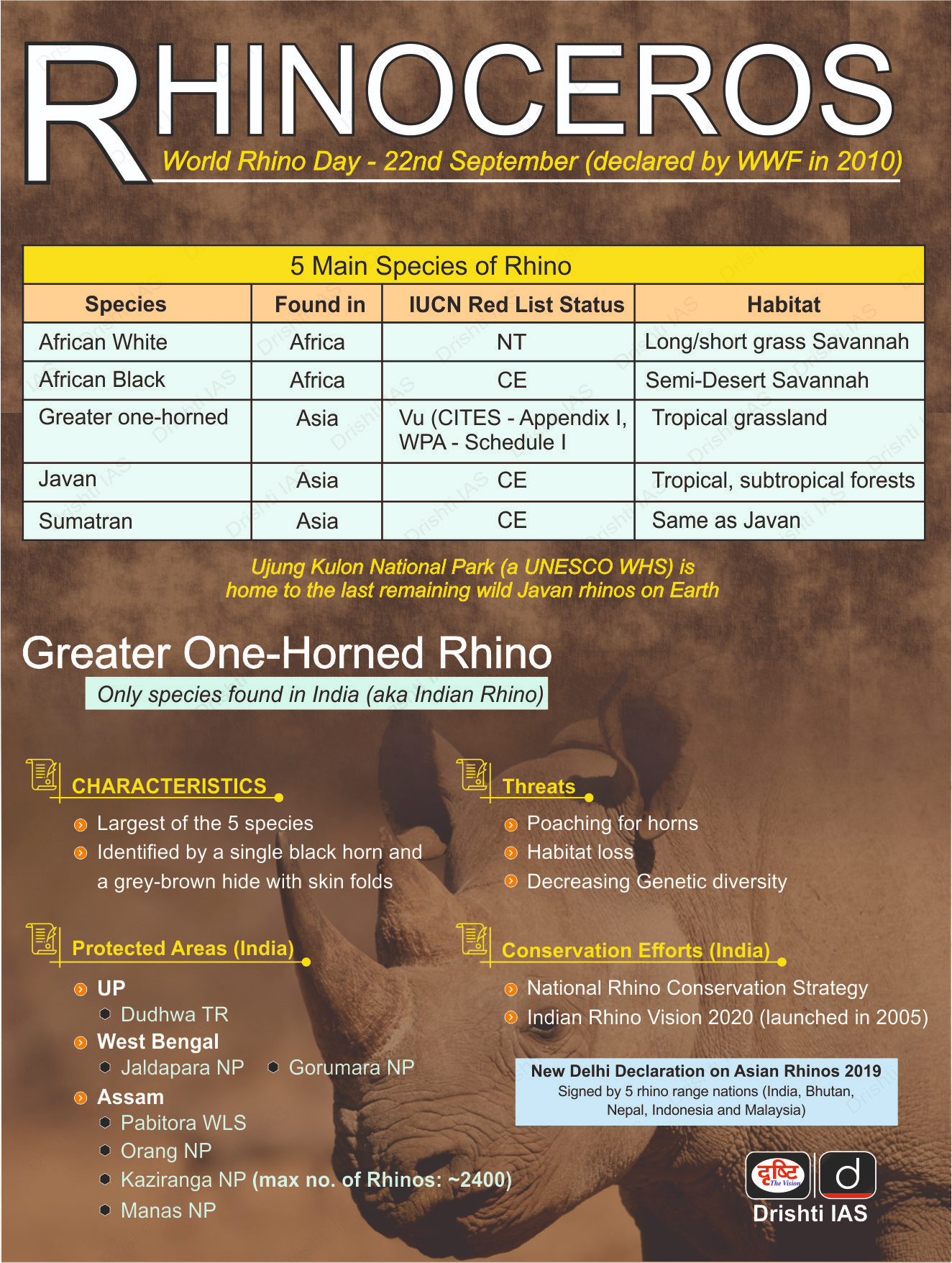State of the Rhino 2023 | 23 Sep 2023
For Prelims: Types of Rhinos,World Rhino Day, State of the Rhino Report
For Mains: Conservation Efforts for Wildlife
Why in News?
Recently, the International Rhino Foundation (IRF) published the report, State of the Rhino, 2023 which documents current population estimates and trends for the five surviving rhino species in Africa and Asia.
- Every year, World Rhino Day is observed on 22th September to spread awareness for all five species of rhino and work being done to save them.
- It was first announced by the World Wildlife Fund (WWF) - South Africa in 2010.
What are the Key Findings of the Report ?
- Major Threats:
- Poaching, Habitat Loss: Poaching still threatens all five rhino species and has increased in several regions that had not previously been targeted.
- South Africa continues to battle devastating poaching losses of its white rhinos.
- Black rhino populations are increasing despite constant poaching pressure.
- Climate Change:
- In Africa, climate change-induced drought is causing myriad detrimental impacts.
- In Asia dramatically increased precipitation and longer monsoon periods could cause more direct deaths of rhinos and humans alike.
- Changing weather conditions and landscapes can also trigger an increase in invasive plant species, crowding out or overtaking native rhino food plants and causing general habitat degradation.
- Poaching, Habitat Loss: Poaching still threatens all five rhino species and has increased in several regions that had not previously been targeted.
- Status of Rhino:
- Javan Rhinos:The status and whereabouts of 12 of the approximately 76 remaining Javan rhinos is unknown.
- Sumatran Rhinos: Signs of Sumatran rhinos are increasingly hard to find, creating more uncertainty about their population in the wild.
- White Rhinos: 2,000 white rhinos from “World’s Largest Rhino Farm” will now be rewilded throughout Africa.
- Bright Spots:
- Greater one-horned rhinos in India and Nepal continue to thrive due to strong protection .
- Black rhinos in Africa are rebounding in the past few decades at a strong growth rate despite still significant poaching losses.
- With the right interventions, all five rhino species can rebound and thrive in our ever changing world.
- Recommendations:
- Implement a holistic strategy to safeguard rhinos by addressing poaching, habitat protection, community involvement, capacity building, demand reduction, advocacy, and wildlife trafficking disruption.
What are the Conservation Efforts by India ?
- Translocation: Rhino translocations to Manas National Park set for the beginning of 2023 were rescheduled for 2024 while security measures were reinforced after a poached rhino was discovered in January.
- Rhino Corridor: In 2022, the Assam government finalized the addition of approximately 200 sq km to Orang National Park in north-central Assam, more than doubling the size of this protected area and key rhino habitat.
- With this added land, Orang National Park is now connected to Burhachapori Wildlife Sanctuary in the east, completing the creation of a linked corridor between all the protected areas in Assam that hold rhinos: Manas National Park, Pobitora Wildlife Sanctuary, Orang National Park, the Laokhowa and Burhachapori Wildlife Sanctuaries and Kaziranga National Park.
- New Delhi Declaration on Asian Rhinos: India, Bhutan, Nepal, Indonesia and Malaysia have signed a declaration for the conservation and protection of the species.
- DNA Profiles of all Rhinos: The project will help in curbing poaching and gathering evidence in wildlife crimes involving rhinos
- National Rhino Conservation Strategy: It was launched in 2019 to conserve the greater one-horned rhinoceros.
- Indian Rhino Vision 2020: It was an ambitious effort to attain a wild population of at least 3,000 greater one-horned rhinos spread over seven protected areas in the Indian state of Assam by the year 2020.
UPSC Civil Services Examination, Previous Year Question (PYQ)
Prelims
Q. Consider the following statements: (2019)
- Asiatic lion is naturally found in India only.
- Double-humped camel is naturally found in India only.
- One-horned rhinoceros is naturally found in India only.
Which of the statements given above is/are correct?
(a) 1 only
(b) 2 only
(c) 1 and 3 only
(d) 1, 2 and 3
Ans: (a)


